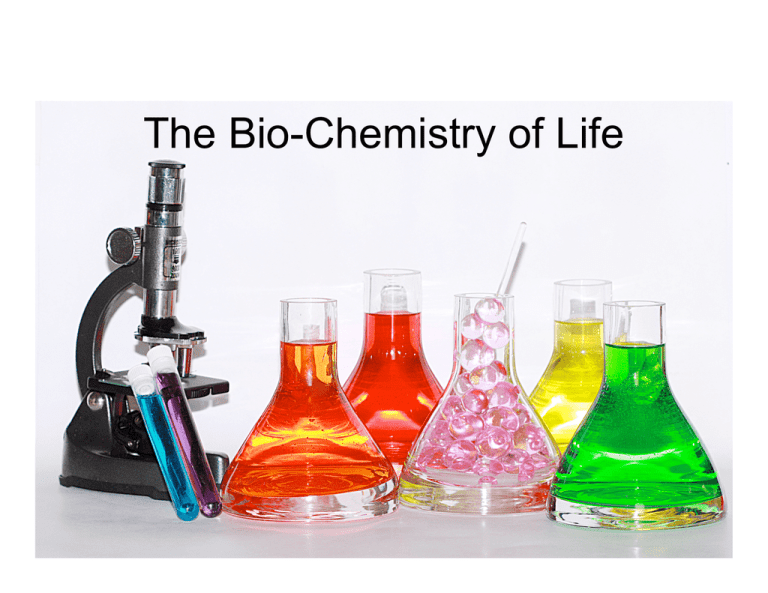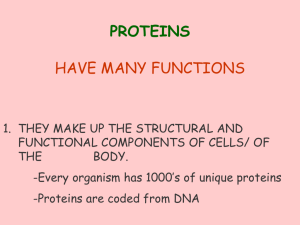The Bio-Chemistry of Life
advertisement

The Bio-Chemistry of Life The Commonality of the Chemistry of Life •All life on Earth utilizes carbon chemistry in aqueous solutions. •All life uses the same 20 amino acids •All life uses DNA (or RNA) to encode genetic information Amino Acids A small organic molecule containing an •amine group (NH or NH2) and •Carboxyl group (COOH) •Plus a side chain (R) Chains of amino acids form proteins Image from http://www.biology.arizona.edu/biochemistry Amino Acids of Life Glycine: NH2CH2COOH the simplest - 10 atoms Arginine: HN=C(NH2)-NH-(CH2)3-CH(NH2)-COOH 26 atoms Tryptophan: Ph-NH-CH=C-CH2-CH(NH2)-COOH 28 atoms 20 Amino Acids of Life Alanine CH3-CH(NH2)-COOH Arginine HN=C(NH2)-NH-(CH2)3-CH(NH2)-COOH Asparagine H2N-CO-CH2-CH(NH2)-COOH Aspartic acid HOOC-CH2-CH(NH2)-COOH Cysteine HS-CH2-CH(NH2)-COOH Glutamine H2N-CO-(CH2)2-CH(NH2)-COOH Glutamic acid HOOC-(CH2)2-CH(NH2)-COOH Glycine NH2-CH2-COOH Histidine NH-CH=N-CH=C-CH2-CH(NH2)-COOH Isoleucine CH3-CH2-CH(CH3)-CH(NH2)-COOH Leucine (CH3)2-CH-CH2-CH(NH2)-COOH Lysine H2N-(CH2)4-CH(NH2)-COOH Methionine CH3-S-(CH2)2-CH(NH2)-COOH Phenylalanine Ph-CH2-CH(NH2)-COOH Proline NH-(CH2)3-CH-COOH Serine HO-CH2-CH(NH2)-COOH Threonine CH3-CH(OH)-CH(NH2)-COOH Tryptophan Ph-NH-CH=C-CH2-CH(NH2)-COOH Tyrosine HO-p-Ph-CH2-CH(NH2)-COOH Valine (CH3)2-CH-CH(NH2)-COOH (Ph - C6H5 ring) Properties of the Amino Acids of Life Isomers are made of identical atoms, but have different molecular structures. Amino acids are 3-dimensional, and asymmetric. Mirror images are called enantiomorphic isomers. All amino acids in biological proteins are left-handed isomers. Proteins and Peptides Amino Acids form chains by a chemical process called hydrolysis. The OH from the carboxyl group combines with the H from the amino group to make H2O. The C and N bond directly. This is a peptide bond. Enzymes Specific biochemical reactions are unlikely because •of the sheer number of possible reactions •many reactions happen slowly Enzymes are proteins that catalyze specific reactions RNA (not a protein) is a catalyst, because it speeds up the creation of other molecules, including nucleic acids. The Genetic Code The order of amino acids in a protein determines its structure and utility. Randomly arranged amino acids do not produce useful proteins. The order of amino acids is encoded in a molecule called Deoxyribonucleic acid (DNA) or, in some cases, Ribonucleic acid (RNA). DNA and RNA are long chains with a backbone made of a sugar (deoxyribose) and a nucleic acid. Nucleic Acids DNA utilizes 4 nucleotides, or bases: • Cytosine ( C) • Adenine (A) • Guanine(G) • Thymine (T) In RNA, Uracil (U) replaces Thymine Nucleotides consist of a Pyrimide (C4N2) ring or Purine (C5N4) double ring Image from biology.clc.uc.edu/graphics/bio104/nucleotide.jpg Codons The order of the nucleotide bases determines the amino acid sequence. There are 4 bases. •1 base can encode 4 amino acids •2 bases can encode 42, or 16 amino acids •3 bases can encode 43, or 64 amino acids 3 base pairs are called a codon The Genetic Alphabet TTT Phe TCT Ser TAT Tyr TGT Cys TTC Phe TCC Ser TAC Tyr TGC Cys TTA Leu TCA Ser TAA STOP TGA STOP TTG Leu TCG Ser TAG STOP TGG Trp CTT Leu CCT Pro CAT His CGT Arg CTC Leu CCC Pro CAC His CGC Arg CTA Leu CCA Pro CAA Gln CGA Arg CTG Leu CCG Pro CAG Gln CGG Arg ATT Ile ACT Thr AAT Asn AGT Ser ATC Ile ACC Thr AAC Asn AGC Ser ATA Ile ACA Thr AAA Lys AGA Arg ATG Met* ACG Thr AAG Lys AGG Arg GTT Val GCT Ala GAT Asp GGT Gly GTC Val GCC Ala GAC Asp GGC Gly GTA Val GCA Ala GAA Glu GGA Gly GTG Val GCG Ala GAG Glu GGG Gly *When within gene; at beginning of gene, ATG signals start of translation. Redundancy With 64 ways to encode 20 amino acids (plus start/stop), the alphabet is • redundant, and • robust against many single-base mutations. DNA and RNA DNA is a double-stranded helix with complementary base pairs. (T pairs with A; C pairs with G) RNA is single stranded, and usually is used as a messenger (mRNA) or to carry amino acids (tRNA). •DNA untwists. •RNA is built using the DNA as a template. •The RNA is read in a ribosome, where the protein is assembled. Genes A gene is a sequence of base pairs between start and stop codons. It encodes a protein. A strand of DNA (a chromosome) encodes many genes, and a lot of junk (non-coding) DNA. We have 46 chromosomes, and about 20,000 genes The Building Blocks of Life The Murchison meteorite •Carbonaceous chondrite •Fell near Melbourne Australia in 1969 •Contains 92 amino acids •Not all 20 found on Earth •Over 50 not used in life •Equally left and right enantiomorphs Molecular Clouds Building Blocks Molecules in the Interstellar Medium or Circumstellar Shells (as of 09/2011) 2 atoms H2 AlF AlCl C2** CH CH+ CN CO CO+ CP SiC HCl KCl NH NO NS NaCl OH PN SO SO+ SiN SiO SiS CS HF SH* HD FeO (?) O2 CF+ 3 atoms C 3* C 2H C 2O C2S CH2 HCN HCO HCO+ HCS+ HOC+ H2O H 2S HNC HNO MgCN MgNC N2H+ N 2O NaCN OCS SO2 c-SiC2 CO2* NH2 H3+* H2D+, HD2+ SiCN AlNC SiNC 4 atoms c-C3H l-C3H C 3N C 3O C3S C2H2* NH3 HCCN HCNH+ HNCO HNCS HOCO+ H2CO H2CN H2CS H3O+ c-SiC3 CH3* C4 5 atoms C 5* C 4H C4Si l-C3 H2 c-C3H2 CH2 CN CH4 * HC3N HC2 NC HCOOH H2CNH H 2C 2O H2NCN HNC3 SiH4* H2COH+ 6 atoms 7 atoms C 5H C6H l-H2C4 CH2 CHCN C 2H 4* CH3C2H CH3CN HC5 N CH3NC CH3CHO CH3OH CH3NH2 CH3SH c-C2H4O HC3NH+ H2CCHOH HC2CHO NH2CHO C 5N l-HC4H* (?) l-HC4N Building Blocks II Molecules in the Interstellar Medium or Circumstellar Shells (as of 09/2011) 8 atoms 9 atoms CH3C3N CH3C4H HCOOCH3 CH3CH2 CN CH3COOH (CH3 )2O C7H CH3CH2OH H2C6 HC7N CH2OHCHO C8H l-HC6 H* (?) CH2CHCHO (?) 10 atoms 11 atoms CH3C5N HC9N (CH3)2 CO (CH2OH)2 (?) H2NCH2COOH CH3CH2CHO 12 atoms C6 H6* (?) CH3OC2H5 13 atoms HC11N





